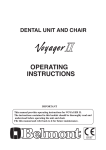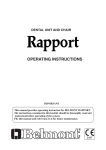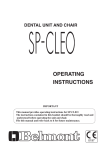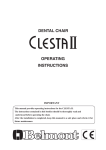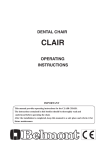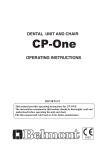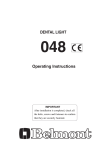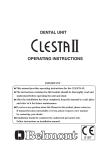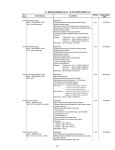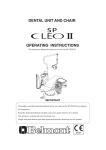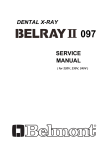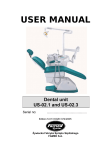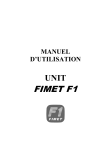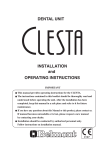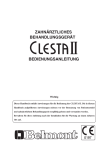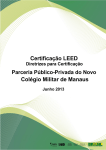Download OPERATING INSTRUCTIONS
Transcript
DENTAL UNIT AND CHAIR OPERATING INSTRUCTIONS IMPORTANT This manual provides operating instructions for VOYAGER-II L. The instructions contained in this booklet should be thoroughly read and understood before operating the unit and chair. File this manual and refer back to it for future maintenance. 0197 TABLE OF CONTENTS Page SAFETY PRECAUTIONS------------------------------------------------------- 1 1. OVERALL VIEW AND MAJOR COMPONENTS---------------------------- 5 2. DIMENSIONS AND SPECIFICATIONS 2-1. DIMENSIONS----------------------------------------------------------------- 6 2-2. SPECIFICATIONS------------------------------------------------------------ 6 3. OPERATING INSTRUCTIONS FOR UNIT 3-1. MASTER SWITCH----------------------------------------------------------- 7 3-2. DOCTOR TABLE SECTION------------------------------------------------ 7 3-3. CUSPIDOR SECTION------------------------------------------------------- 8 3-4. ASSISTANT INSTRUMENT HOLDER SECTION---------------------- 9 3-5. FOOT CONTROL SECTION------------------------------------------------ 9 3-6. SWING ARM SECTION----------------------------------------------------- 9 3-7. DOCTOR TABLE SAFETY LOCK DEVICE----------------------------- 9 4. OPERATING INSTRUCTIONS FOR CHAIR 4-1. MAIN SWITCH-------------------------------------------------------------- 10 4-2. CONTROLS------------------------------------------------------------------- 10 4-3. SAFETY LOCK DEVICE--------------------------------------------------- 11 4-4. HEADREST OPERATIONS------------------------------------------------ 11 4-5. AUTO MODE POSITION ADJUSTMENT------------------------------ 11 5. RIGHT/LEFT HANDED DENTISTRY CONVERSION-------------------- 12 6. CARE AND MAINTENANCE 6-1. CARE AND MAINTENANCE FOR CHAIR---------------------------- 12 6-2. CARE AND MAINTENANCE FOR UNIT------------------------------ 13 7. BEFORE ASKING FOR REPAIRS---------------------------------------- 17 8. MAINTANANCE AND INSPECTION----------------------------------- 18 9. ELECTROMAGNETIC COMPATIBILITY----------------------------------- 21 10. LIST OF COMPATIBLE HANDPIECES ------------------------------------- 23 Intended Use of the Product This product is an active therapeutic device intended for the exclusive use for diagnoses, treatments and relative procedures of dentistry. The product must be operated or handled by the qualified dentists or by dental staffs under the supervision of the dentist. Such dentists or dental staffs should instruct and/or assist the patients to approach to and leave from the product. Patients should not be allowed to operate or handle the product unless he/she is so instructed. The product is supplied together with the handpieces like electric micromotor, air turbine and/or motor, scaler and so on. Environmental Requirements Ambient Temperature Operating +5℃ - +40℃ Humidity 10 % - 80% Storage -10℃ - +50℃ Atmospherical Pressure 600 hPa - 1060 hPa Compatibility of Handpieces Use the compatible handpieces as shown on the attached list for this unit. (List of compatible handpieces). Important Notes In case of the troubles, please contat Takara Belmont offices or your dealers. Do not disassemble or attempt to repair. Disassembly, repair or modifications shoud only be done by a qualified repair technician. Attempts at disassembly, repair or modifications may lead to abnormal operation and accidents. Disposal of residue material Please request a special contractor when you dispose amalgam. In case of disposal of equipment When disposing the unit and chair, appropriately dispose complying with all current applicable regulations and local codes. In EU area, EU directive 2002/96/EC on waste electrical and electronic equipment (WEEE) is applied on this product. In this directive, environment conscious recycling/abandonment is obligated. SYMBOLS Protective earth (ground) Alternating current ON (power) OFF (power) Chair last position Chair auto return Chair preset1 Chair preset2 To raise the chair To Recline the backrest To lower the chair To raise the backrest Air Non-ionizing radiation Authorized representative in the European community Type B Applied Parts Water 㸶 Manufacturer Date of manufacture 㻨㻦 Caution It means “caution, warnings, or possibility to danger”. Separate collection for electrical and electronic equipment Chair manual control 㹌 㻵㻨㻳 Autoclave Symbol This symbol on component means that the component can be sterilised with an autoclave at 135℃ max. Refer to instruction manual/booklet SAFETY PRECAUTIONS For proper operation, please carefully read through the Safety Precautions before using the product. Items described herein are provided in order to ensure safe and appropriate use of the product, and to prevent property damage or personal injury to the operator and other persons. Furthermore, the precautions describe potential hazards due to improper handling and classify hazards according to degree of damage and level of urgency. Please be sure to read the items and precautions as they both relate to safety. Division of caution level Magnitude of danger and damage and extent of urgency WA R N I N G CAUTION NOTICE This word refers to precautions that if ignored may result in fatal or serious injuries. This word refers to precautions that if ignored may result in minor or moderate injury or property damage. This word refers to precautions regarding safety. WA R N I N G 1. Be sure to switch off the breaker for the equipment when it will not be in use for a long period of time. When the equipment will not be in use for a long period of time, such as at the end of the day or a non-business day, be sure to switch off the applicable breaker in the office and disconnect the power plug from the outlet. Failure to heed this warning may result in electrical leakage or fire due to deterioration of insulation. 2. Be sure to turn off the main switch at the end of the day and during break times. Be sure to turn off the main switch at the end of the day and during break times. This will prevent malfunctions and resulting hazards due to accidental contact with the equipment. 3. Do not attempt to disassemble, repair or modify the equipment. Only authorized personnel should disassemble, repair or modify the equipment. Failure to heed this warning may cause an accident, failure, electrical shock, or fire. 4. Be sure to ground the equipment Be sure to ground the equipment firmly and correctly. (To ground the equipment, contact a qualified technician.) Failure to heed this warning may result in electrical shock during failure or electrical leakage. 5. Pay attention when exposing the equipment to electromagnetic interference. The product may malfunction when exposed to electromagnetic interference. Do not install the product close to communication equipment or an elevator that generates electromagnetic waves. In addition, do not use devices such as a mobile phone that generates electromagnetic waves in the vicinity of the product. 6. Be sure to turn off the main switch when a high frequency surgical instrument (HF-Surg) is used. Use of a HF-Surg may cause the equipment to malfunction due to generated noise. Be sure to turn off the main switch when using the HF-Surg. 7. Use caution towards patients with a pacemaker. Use caution towards patients with a pacemaker. If the patient experiences anything unusual while product is operating, immediately turn off the power of the product and discontinue use. 8. Never fail to carry out maintenance and inspections. Using the product without performing maintenance and inspection programs may result in bodily injury or property damage. Refer to the section for maintenance and inspections. 9. Be sure to mount the mirror cover. The mirror cover for the dental light must be attached whenever the light is used. Touching the light bulb may result in burns. Refer to the operating instructions on the dental light for details. 10. Be sure to turn off the power when replacing the light bulb. The power must be turned off when replacing the dental light bulb. Failure to heed this warning may result in electrical shock. The specified halogen light bulb must be used. The bulb and the bulb holder may be hot. Wait until they become cool before replacing the bulb. Do not touch the halogen bulb with bare hands. Refer to the operating instructions on the dental light for details. -1- SAFETY PRECAUTIONS WA R N I N G 11. Do not place articles weighing 3 kg or more on the instrument table. Do not place articles weighing 3 kg or more on the instrument table. Failure to heed this warning may result in breakage, malfunction of the table, or an accident. 12. Do not apply excessive force to the arms. Do not mount or apply unnecessary force to the unit arms or the armrests of the patient chair. Failure to heed this warning may cause an accident or the unit to tip over. 13. Do not sit on other than seat When the backrest is at the forward position. do not sit on or place an undue load on the headrest or legreat of dental chair. This could cause the unit to topple or could damage the unit. 14. Do not place a load on the top of the unit. Do not get on, sit on or place heavy objects on the top of the unit. Damage to the top of the unit may result in physical injury. 15. Immediately wipe off any water spills or leakage on the floor Immediately wipe off any water spills or leakage on the floor. Decreased strength of the floor may lead to physical injury including fall, or property damage. 16. Take action for power fail Shut down the main switch of Doctor`s table after power fail recovery due to avoid the unexpected movement. CAUTION 1. The system must be operated or handled by a qualified dentist or by dental staff under the supervision of a dentist. Persons other than dentists or other dental professionals must not use the system. 2. Check safety before operating the product. Before operating the system, be sure to check that all parts operate normally and safely, and that there are no obstacles in the area. 3. Pay attention to the patient and children. Be careful to avoid accidents due to mischief or careless operations by the patient (children in particular). Keep an eye on the patient. 4. Stop operation of the system when feeling something is wrong. During inspections, pay attention to any looseness, wobbling, inclination, vibration, abnormal sounds, temperatures, or odors. If something is out of place, even slightly, immediately stop operating the system. 5. Do not strongly hit or scrape the system. Do not strongly hit or scrape the system. Failure to heed this caution may result in breakage of the cover or malfunction of the system. 6. Be sure to operate the switches by hand. Except for the footswitch, be sure to operate the switches by hand. Operation of switches by means other than hands may result in breakage or system malfunction. 7. Take caution when using water other than city water. The system is designed for use with city water. Use of water other than city water (such as water-line sterilization system) may result in system failure. 8. Request for flushout of water staying in the unit In order to maintain the quality of the treatment water to stably supply water to the handpieces, be sure to thoroughly flush out any remaining water in the unit before starting treatment. Refer to the pages for the flushing out procedures. -2- SAFETY PRECAUTIONS CAUTION 9. Cautions when shifting/moving the instrument table: When moving the instrument table, pay attention to the surrounding area. Failure to heed this warning may result in injuries by the tips of the handpieces. The instrument table must be moved with the handle of the unit. 10. Do not place hot objects on the instrument table. Do not place hot objects on the instrument table. Failure to heed this warning may result in deformation or discoloration of the table. 11. Do not place anything articles on the Doctor's table Do not place anything articles on the Doctor's table when the table part is moved up and down. 12. Be sure to wipe chemicals off immediately when spilled on the system. If chemicals or water are spilled on the system, immediately wipe off with a dry, soft towel. Failure to heed this warning may result in system malfunction, electrical leakage, stains, or rust on the equipment. 13. Take care not to activate the water heater without water in it. Activating the water heater without water in it will burn out the heating element, resulting in fire. 14. Be sure to use the cover over the scaler tip. After using the scaler, be sure to use the designated tip cover (for models with a cover) before placing it in the holder. Without the cover, there is a possibility of injury caused by the scaler tip. 15. Observe the following when handling handpieces: Change the rotation speeds of the micro-motor and detach the burr of the handpieces only after motor rotation comes to a complete stop for safety purposes. Refer to the operating instructions that come with each handpiece for details. 16. Observe the following when handling the film viewer: Handle the film viewer carefully, since a fluorescent lamp is encased. Be sure to turn off the lamp when not in use. 17. Pay attention the interference between table and chair The cart type has no safety switch, so pay attention the interference between chair and unit when chair is moved. 18. Observe the following concerning the cart hose: Do not tread on the cart hose. Failure to heed this warning may result in damage to the hose, as well as people tripping over. 19. Cautions when adjusting the height of the cart-type instrument table: After adjusting the height, be sure to fasten the loosened lock screw. Failure to heed this warning may cause the table to shift, resulting in an accident. 20. Pay attention to entrapment during automatic operation of the treatment unit. During automatic operation of the treatment unit, pay attention to surrounding areas before initiating operations. Failure to heed this warning may result in breakage of the backrest, stool, or instrument table. Furthermore, check that the patient is in the correct position and always monitor the patient during system operation. 21. Pay attention during the headrest operation Do not allow hands, fingers, or hair to become entangled in the moving parts of the headrest during operationg. 22. Precautions in handling of the gas burner Keep the gas burner way from flammable materials. This may cause a fire. Be sure to extinguish the flame and turn off the main valve when the gas burner is not in use. 23. Caution when cleaning the control panel (membrane switch): Seepage of sterilization liquid into the back of the membrane sheet will cause switch failure. Be sure to use a paper towel applied with sterilization liquid to clean the membrane sheet surface. -3- SAFETY PRECAUTIONS 24. Precautions for use of handpieces CAUTION Handpieces may have poor spraying performance or generate heat due to the lack of cooling water/cooling air. In the case of the development of heat or an odor of something burning, immediately discontinue use and contact the dealer or our company because burns may occur or dental pulp may be adversely affected. 25. Do not use the water cleaning filter in a setting where freezing is expected Do not use the water cleaning filter in a setting where freezing is expected. Damage to parts may lead to water leakage. 26. Observe the following when cleaning the Spittoon bowl: Never use sandpaper, wire wool, or detergents containing abrasive compounds to clean the Spittoon bowl. Do not use overly acidic or alkaline pipe cleaning agents, as they may corrode metals. 27. Caution when cleaning the plastic covers: When cleaning the plastic covers, use only the desinfectant (Durr FD333) recommended by this company or a diluted neutral detergent, or the plastic cover may crack. After cleaning, make sure to wipe off all residue with a dry and soft cloth. 28. Air pressure of the clean water system (optional) must be less than 0.2Mpa. The air pressure to the clean water system must be regulated to less than 0.2Mpa. Excessive pressure may rupture the clean water system. 29. Do not use water for the clean water system (optional) other than purified water, distilled water or pure water. For the clean water system use only purified water, distilled water or pure water. Do not use such as mouth wash or electrolytic solution which may cause clogging in tubings or adverse effect on inner valves and instruments. 30. Close the water main valve at the end of the day. Make sure to close the water main valve at the end of the day to prevent a water leakage. 31. Read the documents accompanying the various pieces of equipment Before use, be sure to carefully read the package inserts and Instruction Manuals accompanying the various pieces of equipment (including optional articles) to ensure proper use. 1. Troubleshooting and contact information NOTICE In the case of any problems, discontinue use, turn off the main switch and contact the dealer or our company. 2. Operational check of the air compressor: If air is not supplied to the product, the system will not function even if the main switch is turned on. Before operating the product, turn on the power to the air compressor. 3. The air turbine must be of the type with a water check valve. The air turbine must have a water check valve. If the turbine is not the correct type, contact your dealer or our company. 4. Handling of the system during power failure: If the system stops during operation due to a power failure, place the handpiece in the holder, and turn off the main switch. 5. Function of the flow adjustment valve/knob The function of the flow adjustment valve/knob is to regulate, not to stop, air/water flow. Do not overly tighten the valve/knob or the knob may break. -4- 1. OVERALL VIEW AND MAJOR COMPONENTS 1 2 20 3 4 13 12 11 5 16 17 9 19 21 10 18 14 8 7 15 Chair base front left 6 Fig.1-1 Overall View and Major Parts MAJOR PARTS 13. Armrest 1. Light Pole 2. Cuspidor Bowl 3. Cuspidor Unit 4. Assistant Holder 5. Doctor Table 6. Doctor Arm 7. Doctor Arm Cover 8. Foot Control 9. Headrest 10. Backrest 11. Seat 14. Foot Switch 15. Power Switch 16. Pump Cover 17. J-Box Cover 18. Presuure Gauge 19. Stop Valve for Water 20. Dental Light 048-VG 21. Handpieces (Micromotor, Air Turbine/Motor, Scaler and etc.) Manufacturers recommend to use the handpieces with CE markings 12. Seat Cover -5- 2. DIMENSIONS AND SPECIFICATIONS 2-1. DIMENSIONS -mm- ° 0° ° 280 350 170 675 85° 430 575 13 80 R4 60 13 0° 570 305 ° 215 ° 72 370 730 470- 850 10° 70° 480 1740 75 58 650 1205 2015 565 1365 Fig.2-1 Dimensions 2-2. SPECIFICATIONS Power Consumption---------------------- AC230V, 50/60Hz, 3.7/3.7A Fuse----------------------------------------- 5A/250V(Current Rating:50A at 250VAC) Fast-blow Control Voltage--------------------------- DC12V Air main pressure--------------------------- 0.45 to 0.5MPa Water main pressure------------------------ 0.1 to 0.2MPa Seat initial Height------------------------ 470mm Seat Lifting Stroke----------------------- 380mm Backrest Movement---------------------- 0˚ ~ 72˚ above Horizontal Auto Movements------------------------- 2 Preset, 1 Last Position Memory and 1 Auto Return Net Weight--------------------------------- 140 kg (Chair), 67 kg (Unit, With Dental Light) Maximum Load--------------------------- 135 kg Doctor Side Handpiece------------------ 1 x High Speed Turbine Tubing 1 x Low Speed Air Motor Tubing 1 x 3-Way Syringe Assistant Side Handpiece---------------- Saliva Ejector (Central System Type) Vacuum (Central System Type) Bowl Flush-------------------------------- Manual Control Cupfiller------------------------------------ Manual Control Dental Light------------------------------- 048-VG Type Service Life- ------------------------------ 10 years Mode of operation -------------------------- Non-Continuous Operation ON time:3 min, OFF time:15 min Classification of foot controller ----------- IPX1(applicable standard IEC60529) Protection class against electric shock --- Class I equipment Applied parts --------------------------------- Type B applied parts : Seat for chair, Handpiece for unit (List of compatible handpieces) Equipment that is not suitable for use in air, flammable anesthetic gas, oxygen or nitrous oxide -6- 3. OPERATING INSTRUCTIONS FOR UNIT Note : Before operation, confirm that air compressor is fully charged. The chair can be operated only when both the chair main switch and the master switch are ON. Refer to 4-1. Master Switch ON MA IN OFF ON OFF HP2 3-1. MASTER SWITCH (Fig.3-1 and Fig.3-2) Turn on the master switch located under the doctor table, the master switch indicator located on the front side of the cuspidor unit turns to green. CAUTION Turn off the master switch after daily operation. 3-2. DOCTOR TABLE SECTION (1) Handpiece Spray Water Flow Control Knobs (Fig.3-1) The handpiece spray water flow control knobs located under the doctor table provide for individual adjustment. Each handpiece spray water flow control knob is lined up from the facing left hand side HP1, HP2... Turning a flow control knob counterclockwise increases flow volume and turning clockwise decreases. (2) 3-Way Syringe A. 3-Way Syringe Operation (Fig.3-3) Depressing either or both buttons, this syringe offers air, water and spray. Syringe tip can be rotated freely. To remove syringe tip : Keep depressing the lock ring and pull out the syringe tip. To set syringe tip : Keep depressing the lock ring, insert the syringe tip and release the lock ring. HP1 Handpiece Spray Water Control Knobs Fig. 3-1 Master Switch and Handpiece Spray Water Control Knobs Master Switch Indicator Cuspidor Unit Fig. 3-2 Master Switch Indicator Syringe Tip Lock Ring Water Button Air Button Fig. 3-3 3-Way Syringe B. 3-Way Syringe Flow Control Screws (Fig.3-5) Air and/or water flow of 3-way syringe can be Flow Control adjusted by the flow control screws located Screw (Water) bottom of the table. Decrease Increase Facing right hand side screw controls air and left hand side controls water. Hex Key Wrench Control Turning a flow control screw counterclockwise Flow Screw (Air) increases flow volume and turning clockwise decreases. Use the hex key wrench supplied. Fig. 3-4 3-Way Syringe Flow Control Screws ON IN MA OFF HP2 -7- HP1 (3) Removing Table Top (Fig.3-5) Loosen 4-screws from the table bottom and remove the table top. The auto select valve and the handpiece pressure gauge are located in the table. Table Top Cover (4) Handpiece Drive Air Adjustment Screws (Fig.3-6 & Fig.3-7) Adjustment of drive air of each handpiece can be made by the screw on the auto select valve. It is important to set the drive air pressure in according with the handpiece manufacture's recommendation. Drive air pressure is indicated by the handpiece pressure gauge. Note : Refer to 3-5 for handpiece control Setting The Optimum Condition (Fig.3-7) Turn the appropriate dive air screw fully clockwise, then depress the drive air pedal of the foot control fully (maximum foot pressure) and turn the screw counterclockwise slowly. Stop turning the screw immediately when the handpiece pressure gauge shows the desired drive air pressure. (5) Handpiece Coolant Air Adjustment Screws (Fig.3-6 & Fig.3-7) Handpiece coolant air adjustment screws are provided for individual adjustment of handpiece coolant air. Turning a handpiece coolant air adjustment screw counterclockwise increases flow volume and turning clockwise decreases. (6) Handpiece Refer to handpiece manufacturers operating instructions. 3-3. CUSPIDOR SECTION (1) Cupfiller (Fig.3-8) Keep pressing the cupfiller button until a cup is filled with water. (2) Bowl Flush (Fig.3-8) Turn the bowl flush control knob counterclockwise, water flushes into the cuspidor bowl. Further turning counterclockwise, increases the amount of flush water. -8- ON MA IN OFF HP2 HP1 Table Top Fixing Screws Fig. 3-5 Removing Table Top Cover Auto Select Valve View A HP1 HP2 Handpiece Pressure Gauge (HP3) Fig. 3-6 Auto Select Valve and Pressure Gauge Drive Air Screw HP1 HP2 (HP3) Coolant Air Screw View A Fig. 3-7 Auto Select Valve Cupfiller Button Decrease Increase Bowl Flush Control Knob Fig. 3-8 Cupfiller and Bowl Flush 3-4. ASSISTANT INSTRUMENT HOLDER SECTION Pick up an instrument (Saliva Ejector or Vacuum Handpiece) from the assistant instrument holder, it starts working automatically. Returning the instrument to the assistant instrument holder stops it automatically. Chip Blower Button Drive Air Pedal ON OFF 3-5. FOOT CONTROL SECTION (Fig.3-9) (1) Drive Air Pedal Depressing the drive air pedal controls handpiece rotation speed and coolant air on/off. Spray Water ON/OFF Switch On Off Chip Blower Button Coolant Water On/Off Switch (2) Spray Water ON/OFF Switch Spray water ON/OFF switch allows water to be turned on or off. Refer to 3-2 (1) of this manual for adjusting water of each handpiece. Drive Air Pedal Fig. 3-9 Foot Control (3) Chip Blower Button By depressing the chip blow button, chip blower comes out from handpiece without bur turning. Upper Swing Arm Post Stopper Ring (4) Safety Device by Foot Control When the drive air pedal is being depressed and handpiece is running, all the chair control switches are inactivated. This is to prevent the chair from unexpected movement by any switch being touched accidentally. Lower Swing Arm 3-6. SWING ARM SECTION Table Height Adjustment (Fig.3-10) Hold and slightly lift up the doctor table, stopper ring will come up on upper swing arm post. Slide up or down the stopper ring to appropriate groove on upper swing arm post. Lower the doctor table to fix it at that height. 3-7. DOCTOR TABLE SAFETY LOCK DEVICE (Fig.3-11) If excess pressure (upward or downward) is applied to the doctor table by the movement of chair, safety device stops the chair movement to protect the table from being damaged. -9- Fig. 3-10 Swing Arm Upward Doctor Table Downward Fig. 3-11 Doctor Table Safety Lock Device 4. CHAIR OPERATING INSTRUCTIONS 4-1. MAIN SWITCH (Fig.3-1 & Fig.4-1) Turn on the master switch located at the left side of the pump cover, main switch illuminates in green. Note : Chair main switch will not activate unless master switch of unit is turned on. Refer to 3-1. CAUTION I (ON) Operate the main switch only by hand. Turn off the main switch after daily operation. Fig.4-1 Main Switch 4-2. CONTROLS (Fig.4-2) CAUTION Before operating the chair, confirm safety for the patient and the operator. Main Switch O (OFF) All chair electrical movements can be controlled by the foot switch. Foot Switch Disc Preset-2 Preset-1 2 1 0 Auto Return LP Last Position Memory (1) Manual Mode Control Fig.4-2 Foot Switch A. Seat Lifting Keep depressing ( ) side of the foot switch disc until the seat is lifted up to the desired position. B. Seat Lowering Keep depressing ( ) side of the foot switch disc until the seat is lowered to the desired ) side of the foot switch disc until the backrest is rased up to the desired position. C. Backrest Reclining Keep depressing ( ) side of the foot switch disc until the backrest is reclined to the desired position. D. Backrest Raising Keep depressing ( position. (2) Auto Mode Control E. Preset Control VOYAGER II chair has two preset positions. (Preset-1 and Preset-2) Momentarily depress ( 1 ) button on the foot switch, the chair will move to the preset-1 position automatically. (Preset-2 is operated by ( 2 ) button.) F. Auto Return Momentarily depress ( 0 ) button on the foot switch, the chair will return to the initial position (The seat is fully lowered and the backrest is upright position.), G. Last Position Memory Momentarily depress (LP) button at treatment position, the backrest and seat will move to the mouth rinsing position automatically. Momentarily depress (LP) button again, the backrest and seat will return to the previous treatment position automatically. -10- H. Emergency Stop During automatic procedure (Preset, Auto return and Last position memory), depressing any side of disc or button on the foot switch will cancel the automatic movement immediately. Note : Do not keep depressing auto mode button ( 1 )( 2 )( 0 )(LP) over 3 seconds. Memorized position in auto mode may be changed. 4-3. SAFETY LOCK DEVICE (Fig.4-3) All chair movements can be stopped automatically by the safety lock device when pressure is detected between the base and the lower link cover. In case that the safety lock device works, lift up the seat and remove a cause of pressure. Note : Seat lifting and backrest rasing can be operated by manual foot switch disc even when the safety lock device is working. 4-4. HEADREST (Fig.4-4) (1) Height Adjustment Press down or pull up the headrest to the desired height. (2) Angle Adjustment Push the headrest forward as required. Lift the headrest lever to rotate backward and release the lever at the desired angle. Lower Link Cover Safety Lock Device Base Fig.4-3 Safety Lock Device Angle Adjustment Headrest Lever Height Adjustment Fig.4-4 Headrest 4-5. AUTO MODE POSITION ADJUSTMENT (1) Preset position Adjustment (Fig.4-5) Two preset positions can be memorized. A. Set the seat and the backrest to the desired preset position by manual control. B. Keep depressing ( 1 ) button until buzzer sounds (in about 3 seconds), then release it. C. The position is memorized in Preset-1. D. Preset-2 can be memorized by depressing ( 2 ) button as following A to C. Foot Switch Disc Preset-2 Preset-1 2 1 0 LP Auto Return Last Position Memory Fig.4-5 Foot Switch (2) Mouth Rinsing Position Adjustment (Fig.4-5) Mouth rinsing position in last position memory movement can be adjusted. A. Set the backrest and seat to the desired mouth rinsing position by manual control. B. Keep depressing (LP) button until buzzer sounds (in about 3 seconds) and release the button. C. This position is memorized as mouth rinsing position. -11- 5. RIGHT/LEFT HANDED DENTISTRY CONVERSION 1. Bring the chair to the initial position( at lowest height with backrest upright). 2. Swing the doctor table to cuspidor side fully. 3. Pull up two lock pins(A&B) on cuspidor mount arm, (Fig.5-1) and rotate the cuspidor unit to just behaind the chair. 4. Detach assistant handpiece holder from holder bar by lifting it up. Then rotate the assistant holder bar to the other side, and re-attach the handpiece holder on holder bar. 5. Rotate the cuspidor unit to the other side and set lock pins A& B on cuspidor mount arms to fix the unit. 6. Rotate dental light arm to the other side. Pull Knob A Knob A Knob B Fig.5-1 Location of Knob 3 1 6 2 Knob B 5 4 Fig.5-2 Position for doctor table, cuspidor unit and dental light 6. CARE AND MAINTENANCE CAUTION Turn off the master switch and the main switch after daily operation or in long term interval. 6-1. CARE AND MAINTENANCE FOR CHAIR Other than cleaning, no scheduled maintenance of the chair is required. CAUTION Do not drench the chair for cleaning. Do not use polishing powder, solvents, strong disinfectant and hot water for cleaning. After cleaning, wipe with a dry soft cloth and keep dry. Upholstery can be cleaned with a neutral detergent. Paint parts, metal parts and plastic parts can be cleaned with DURR FD333 cleaner ( or equivalent). Do not drench the chair and unit. Wipe all surfaces dry after cleaning. -12- 6-2. CARE AND MAINTENANCE FOR UNIT (1) Cleaning Unit CAUTION Do not drench the unit for cleaning. Do not use polishing powder, solvents, strong disinfectant and hot water for cleaning After cleaning, wipe with a dry soft cloth and keep dry. All surfaces can be cleaned with DURR FD333 cleaner. Spray the cleaner (DURR FD333) on cloth and wipe the surfaces with the cloth. Do not drench the chair and unit. Wipe all surfaces dry after cleaning. Drain Cap (2) Basket Strainer (Fig.6-1) Take out the drain cap and the basket strainer in centre of the cuspidor bowl and clean them. Basket Strainer Cuspidor Bowl (3) Solid Collector (Fig.6-1) Pull out the solid collector with filter and clean it. Solid Collector Fig.6-1 Basket Strainer and Solid Collector (4) Handpiece 1. Vacuum Handpiece and Saliva Ejector Handpiece For effective sterilization, washing for removing Vacuum Tip contamination and immersion by a cleaning agent are required. Then, rinse by water in Upper Vacuum Cap order to remove residual cleaning agent on medical device. Filter Take following procedures from cleaning to sterilization. * Use the disposable saliva ejector tip. Upper Saliva Ejector Cap Lower Saliva Ejector Cap Lower Vacuum Cap Slide Knob Slide Knob Disassembly (Fig.6-2) Disassemble the handpiece for the preparation of cleaning as the following figures show. Pull the hose connector to disconnect the vacuum hose. -13- Vacuum Handpiece Body Vacuum Hose Hose Connector Saliva Ejector Handpiece Body Saliva Ejector Hose Fig.6-2 Vacuum Handpiece and Saliva Ejector Handpiece Cleaning by hand A. Wipe off the surface contamination by a cloth while rinsing the surface by running clean warm water at 40±5 degrees. (Fig.6-3) Scrub the intubation or hole, slide groove and filter by a cleaning brush or by a tooth brush with running clean warm water at 40±5 degrees. (Fig.6-4) Wipe off by a cloth for the area which brush is unable to reach. (Fig.6-5) B. Rinse thoroughly by distilled water at ordinary temperature or by clean water for more than 1 minute. C. Check whether contamination is removed or not after cleaning. Continue the cleaning if contamination is remained. D. Immersed with an alkaline detergent for 5 minutes. (We recommend to use ID212 made by DURR) E. Rinse thoroughly by distilled water at ordinary temperature or by clean water for more than 1 minute. Cloth Fig.6-3 Surface cleaning Fitting cleaning brush or Tooth brush Slide groove Fig.6-4 Cleaning of hole and sliding part CAUTION Cleaning must be done within 1 hour after use. Throw out and do not take autoclave handpiece for following cases. • Any waste material can not be removed by clogged hole. • Contamination and solid material attached to handpiece can not be removed. Sterilization (Fig.6-7) Vacuum Tip/Vacuum Cap/ Vacuum Handpiece Body/Saliva Ejector Handpiece Body can be autoclave.Vacuum handpiece body and saliva ejector body have to assemble before autoclave. Sterilization with autoclave is permitted up to 250 times. However, sterilization of the slide knob with autoclave is permitted up to 100 times (because of application of load at the time of sliding). Cloth Fig.6-5 Cleaning the area (brush is unable to reach) Autoclave Symbol This symbol on component means that the component can be sterilised with an autoclave at 135℃ max. Fig.6-6 Autoclave Symbol A. Insert the handpiece in a sterilization pouch and seal it. B. Autoclave for 20 min. at 121℃ or 4 min. at 135℃. CAUTION • Sterilization by class B cycles. • Sterilization temperature is 135 degrees or less. • The cap, filter and body are made of resin. They may become deteriorated if they are sterilized in an autoclave many times. • After autoclave sterilization, the cap, filter, body and valve are subject to discoloration, which does not have a negative effect on performance. • The slide knob can be autoclave 100 times and is expendable supplies. • Skip the drying process if the temperature is to exceed 135℃. • If damage occurs to the sterilization pouch, discard and sterilize again using a new pouch. -14- Sterilization pouch Fig.6-7 Vacuum Handpiece and Saliva Ejector Handpiece Storage After cleaning the vacuum tip, keep it in the clean place. Note : Before use the handpieces, apply a white vaseline lightly on the rubber parts (O-Ring) and screws part for long life. 1-2. Cleaning vacuum and saliva ejector lines (Fig.6-8) The sucking unit comes into contact with secretions, spit and blood that contain bacteria every day. Be sure to clean and sterilize it at the end of each work day. Recommended cleaner : Orotol Plus made by DURR. CAUTION Fig.6-8 Cleaning Vacuum / Saliva Ejector Lines Do not use strongly acidic cleaning agents or alkaline pipe cleaning agents, which may cause corrosion of metals, etc/ 2. Micro Motor / Air Motor / Turbine / Scaler Sterilize the handpiece according to manufacturer’s operating manual. 3. Belmont 77 Syringe Disassembly (Fig.6-9) Remove the nozzle from syringe by turning it in direction A. Cleaning by hand A. Wipe off the surface contamination by a cloth while rinsing the surface by running clean warm water at 40±5 degrees. Scrub the tip and joint part of nozzle by a cleaning brush or by a tooth brush with running clean warm water at 40±5 degrees. (Fig.6-10) B Nozzle Cleaning must be done within 1 hour after use. Throw out and do not take autoclave handpiece for following cases. • Contamination and solid material attached to handpiece can not be removed. -15- Syringe body A Nut B. Rinse thoroughly by distilled water at ordinary temperature or by clean water for more than 1 minute. C. Check whether contamination is removed or not after cleaning. Continue the cleaning if contamination is remained. D. Immersed with an alkaline detergent for 5 minutes. (We recommend to use ID212 made by DURR) E. Rinse thoroughly by distilled water at ordinary temperature or by clean water for more than 1 minute. CAUTION wA Fig.6-9 Disassembly Belmont 77 Syringe Cleaning brush or Tooth brush Fig.6-10 Cleaning Belmont 77 Syringe Nozzle Sterilization (Fig.6-11) The nozzle can be sterilized with autoclave. Sterilization with autoclave is permitted up to 250 times. A. Insert the handpiece in a sterilization pouch and seal it. B. Autoclave for 20 min. at 121℃ or 4 min. at 135℃. Apply Vaseline thinly and evenly to the two O-rings after sterilization. Tighten the nut firmly in direction B to undo the nozzle. Sterilization pouch Fig.6-11 Sterilization Belmont 77 Syringe Nozzle CAUTION • • • • Sterilization by class B cycles. Sterilization temperature is 135 degrees or less. Skip the drying process if the temperature is to exceed 135℃. If damage occurs to the sterilization pouch, discard and sterilize again using a new pouch. • Before use, make sure that the nut is firmly tightened. Storage After cleaning the nozzle, keep it in the clean place. 4. Tubing and Hose It is recommended that Durr FD333 be used to clean the exterior parts of tubing and hose. (5) Cleaning Oil Mist Separator (Fig.6-12) Handpiece oil mist separator is located rear side of the doctor table. Once a week open the oil mist separator and clean the oil mist filter. (6) Flush Out System (Fig.6-13) (Option) Flush out switch is located under the doctor table. Take a handpiece from the handpiece holder. Turn on the flush out switch by pulling the lever toward outside. Water flushes from the handpiece to clean water line while the switch is on. Oil Mist Filter Packing Cover Fig.6-12 Cleaning Oil Mist Separator Flush Out Switch ON MA IN OFF ON HP2 HP1 Fig.6-13 Flush Out Switch -16- 7. BEFORE ASKING FOR REPAIRS If any of phenomena described below has occurred, make the following checks before asking for repairs. Phenomenon Check point and result Main switch is not on. The product does not work at all. The chair does not work. Water is not supplied. Vacuum suction does not work. Saliva ejector handpiece does not make suction. Action to be taken Turn on the main switch. Air compressor power is not on. Turn on the power. Equipment circuit breaker in the clinic cabinet panel is not on. Turn on the equipment circuit breaker. Locking device for motion stop is activated. Unlock the device. See page 9 & 11 for SAFETY LOCK DEVICE. Water main valve is closed. Open the water main valve. Water flow rate control valve or knob for handpiece or the like is closed. Open the valve or knob. Vacuum pump power is not on. Turn on the power. Filter of solid collector is filthy. Clean the filter. Filter of vacuum handpiece is filthy. Clean the filter. Filter of saliva ejector handpiece is filthy. Clean the filter. If the unit does not normally work even if actions were taken upon checkup stated above, then stop using the unit, turn off the main switch and contact your dealer or our office. -17- 8. MAINTANANCE AND INSPECTION 8-1. Guide for daily maintenance and inspection (Maintenance and inspection by user) Management of maintenance and inspection of medical equipment should be implemented by the user (medical institution). In case the user does not implement such management, it is permitted that such management is outsourced to a qualified entity such as a medical equipment repair company. For safe use of this product, it is necessary that inspection should be conducted in the specified frequency on the items described below. ಕᏬⅤ᳠ No. Item Frequency Influence if inspection not conducted Inspection method and diagnosis Maintenance required in case of nonconformity 㸦 Check of safety functions Before start Make sure the chair movement stops by any of the following actions. 1.when foot controller pedal is depressed. 2.when Dr.table is moved to upward or downward. 3.when Dr.table is located behind the chair. Unexpected personal Contact your dealer or our injury and troubles may office if any abnormality arises. arise due to motion of the chair during medical treatment and due to pinching between doctor section and chair. 㸧 Check for leakage of water and air Before start Leakage of water and air shall not be observed around the product. The product will not normally work, and troubles may arise. Contact your dealer or our office if any abnormality arises. 㸨 Check of motions of equipment Before start 1.Air turbine revolution, water flow, air flow and so forth shall be free of abnormality. 2.Micromotor revolution, water flow and so forth shall be free of abnormality. 3.Scaler vibration, water flow and so forth shall be free of abnormality. Troubles such as injury in patient's oral cavity and equipment failure may arise. Control the water flow in accordance with "Control of components" described in the instruction manual. If any other abnormality arises, refer to the instruction manual attached to individual equipment. Contact your dealer or our office if recovery is not achieved. 㸩 Check of air turbine bar For each patient Appropriate bar shall be positively mounted. Make sure to refer to the instruction manual attached to individual equipment. The bar will not normally If abnormality such as flaw and deformation is found on the bar, work and troubles may replace the bar in accordance with arise. the instruction manual attached to individual equipment. 㸪 Check of scaler tip For each patient Appropriate tip shall be The tip will not normally positively mounted and be work and troubles may correctly used. arise. Make sure to refer to the instruction manual attached to the scaler. If the tip was worn or deformed, replace the tip in accordance with the instruction manual attached to the scaler. Contact your dealer or our office if any other trouble arises. 㸫 Check of For each tightness of patient syringe nut The nut for fixing the nut of Troubles may arise if Type 77, 3-way syringe shall the nut comes off. be positively tightened. Turn and positively retighten the nut that fixes the nozzle. -18- ಕᏬⅤ᳠ No. Item Frequency Inspection method and diagnosis Influence if inspection not conducted Maintenance required in case of nonconformity 㸬 Care Vacuum and saliva ejector handpiece After closing Flush the suction line, and then clean the filter of the vacuum or saliva ejector handpiece. Faulty suction may arise. Clean the suction line and filter in accordance with "Method for care" described in the instruction manual. 8 Care After closing Clean the cuspidor and dust filter. Faulty water drainage may arise. Execute dust removal and cleaning in accordance with "Method for care" described in the instruction manual. 9 Care After closing Clean the filter of the solid collector. Vacuum suction will become weak. Clean the filter in accordance with "Method for care" described in the instruction manual. 10 Care After closing Chemical, filthy water and so forth shall not be found (attached or remaining) on the product exterior. Discoloration and deterioration to the exterior, and corrosion and rusting to metallic components may arise. Execute wiping in accordance with "Method for care" described in the instruction manual. The product main switch shall be off, and water/air main valves shall be closed. Product failure and troubles may arise. Contact your dealer or our office if the main switch cannot be turned off or if the main valve cannot be closed. Cuspidor section Solid collector Exterior 11 Check of After main switch closing and main valves 12 Product's Once every week No abnormal noise or the like shall be produced from product's moving parts when the product is operated. The product will not normally work and troubles may arise. Contact your dealer or our office if any abnormality arises. 13 Care Once every week Water may enter the air line, and equipment failure may arise. Drain the water from the air filter drain valve. Drain the water from the air filter in accordance with "Method for care" described in the instruction manual. 14 Check of Once every month Check the water pressure and air pressure by reading pressure gauges in the cuspidor section. Basic set pressure : Water: 0.1 to 0.2 MPa Air: 0.45 to 0.5 MPa The product will not normally work, and troubles may arise. Contact your dealer or our office if the set pressure is abnormally high or low. 15 Check of Once every month The table shall be free of inclination, and water shall not flow on the table. Injury caused by falling of goods located on the table and other troubles may arise. Contact your dealer or our office if any abnormality arises. 16 Care Once every month The oil level in the oil mist separator shall be lower than the red line. Normal output will not be Discharge the oil in accordance produced due to inferior with "Method for care" described handpiece exhaust. in the instruction manual. moving parts Drain valve water pressure and air pressure conditions of table section Oil mist separator -19- 8-2. Guide for Periodical Check-up Some parts and components of the products are degraded or deteriorated depending on the frequency of use. Annual check-up and maintenance, as well as replacement of consumable parts, are required. The required parts (including consumable parts) are listed below. It may be different from the following list depending on the option of the unit. For check-up and repair, call a technician of our authorized dealer. Parts and components that require periodical check-up Standard Lifetime No. Parts Description Vacuum handpiece body 3 years 8 Regulator 3 years 2 Saliva ejector handpiece body 3 years 9 Valves 3 years 3 Foot controller 5 years 10 Switches 5 years 11 Film viewer body part 5 years 12 13 14 Pressure gauge 3 years 7 years 5 years No . Parts Description No. Parts Description 1 4 Water supply hose 5 6 7 Drain hose Air supply hose Electric wiring of moving part 3 years 3 years 3 years 5 years Consumable parts No . Parts Description Arm section of moving part Control PCBs. 1 Valve for vacum handpiece body 6 Filter for oil mist separator 2 Vacuum tip 7 Filter (Air & Water) 3 Handpiece tubings 8 Bulb for dental light 4 Vacuum hose 9 O-ring, Packing, Diaphragm 5 Saliva ejector hose Standard Lifetime WARNING Execute the maintenance in accordance with this instraction manual and operating manual attached to each individual equipment ( Dental light, Handpiece, etc..) . Failure to maintain this product may lead to physical injury or property damage. -20- 9.ELECTROMAGNETIC COMPATIBILITY(EMC) Medical electrical equipment needs special precautions regarding EMC and needs to be installed and put into service according to the EMC information provided in this manual. Portable and mobile RF communications equipment can affect medical electrical equipment. The equipment or system should not be used adjacent to or stacked with other equipment. If adjacent or stacked use is necessary, the equipment or system should be observed to verify normal operation in the configuration in which it will be used. Guidance and manufacture’s declaration - electromagnetic emissions The Voyager II L is intended for use in the electromagnetic environment specified below. The customer or the user of the Voyager II L should assure that it is used in such an environment. Emissions test Compliance Electromagnetic environment - guidance RF emissions The Voyager II L uses RF energy only for its internal CISPR 11 function. Therefore, its RF emissions are very low and are Group 1 not likely to cause any interference in nearby electronic equipment. RF emissions The Voyager II L is suitable for use in all establishments, Class B CISPR 11 including domestic establishments and those directly Harmonic emissions connected to the public low-voltage power supply network Class A IEC 61000-3-2 that supplies buildings used for domestic purposes. Voltage fluctuations/ Flicker emissions Complies IEC 61000-3-3 Guidance and manufacture’s declaration - electromagnetic immunity The Voyager II L is intended for use in the electromagnetic environment specified below. The customer or the user of the Voyager II L should assure that it is used in such an environment. IEC 60601 Electromagnetic environment Immunity test Compliance level test level guidance Electrostatic ±6 kV contact ±6 kV contact Floors should be wood, concrete or discharge (ESD) ±8 kV air ±8 kV air ceramic file. If floors are covered IEC 61000-4-2 with synthetic material, the relative humidity should be at least 30%. Electrical fast ±2 kV for power ±2 kV for power Mains power quality should be that transient/burst supply lines supply lines of a typical commercial or hospital IEC 61000-4-4 ±1 kV for input/output ±1 kV for input/output environment. lines lines Surge ±1 kV differential mode ±1 kV differential mode Mains power quality should be that IEC 61000-4-5 ±2 kV common mode ±2 kV common mode of a typical commercial or hospital environment. Voltage dips, short <5% UT <5% UT Mains power quality should be that interruptions and (>95% dip in UT) (>95% dip in UT) of a typical commercial or hospital voltage variations for 0.5 cycle for 0.5 cycle environment. If the user of the on power supply 40% UT 40% UT Voyager II L requires continued input lines (60% dip in UT) (60% dip in UT) operation during power mains IEC 61000-4-11 for 5 cycle for 5 cycle interruptions, it is recommended that 70% UT 70% UT the Voyager II L be powered from (30% dip in UT) (30% dip in UT) an uninterruptible power supply or a for 25cycle for 25cycle battery. <5% UT <5% UT (>95% dip in UT) (>95% dip in UT) for 5 s for 5 s Power frequency 3 A/m 3 A/m Power frequency magnetic fields (50/60 Hz) should be at levels characteristic magnetic field of a typical location in a typical IEC 61000-4-8 commercial or hospital environment. NOTE UT is the a.c. mains voltage prior to applications of the test level. -21- Guidance and manufacture’s declaration – electromagnetic immunity The Voyager II L is intended for use in the electromagnetic environment specified below. The customer or the user of the Voyager II L should assure that it is used in such an environment. Compliance Immunity test IEC 60601 test level Electromagnetic environment - guidance level Portable and mobile RF communications equipment should be used no closer to any part of the Voyager II L, including cables, than the recommended separation distance calculated from the equation applications to the Frequency of the transmitter. Conducted RF IEC 61000-4-6 3 Vrms 150 kHz to 80 MHz outside ISM bandsa 3 Vrms Radiated RF IEC 61000-4-3 3V/m 80 MHz to 2.5 GHz 3 V/m Recommended separation distance d = 1.2√P d = 1.2√P 80 MHz to 800 MHz d = 2.3√P 800 MHz to 2.5 GHz Where P is the maximum output power rating of the transmitter in watts (W) according to the transmitter manufacturer and d is the recommended separation distance in metres (m). Field strengths from fixed RF transmitters, as determined by an electromagnetic site survey,a should be less than the compliance level in each frequency range.b Interference may occur in the vicinity of equipment marked with the following symbol: NOTE 1 At 80 MHz and 800MHz, the higher frequency range applies. NOTE 2 These guidelines may not apply in all situations. Electromagnetic propagation is affected by adsorption and reflection from structures, objects and people. a Field strengths from fixed transmitters, such as base stations for radio (cellular/cordless) telephones and land mobile radios, amateur radio, AM and FM radio broadcast and TV broadcast cannot be predicted theoretically with accuracy. To assess the electromagnetic environment due to fixed RF transmitters, an electromagnetic site survey should be considered. If the measured field strength in the location in which the Voyager II L is used exceeds the applicable RF compliance level above, the Voyager II L should be observed to verify normal operation. If abnormal performance is observed, additional measures may be necessary, such as reorienting or relocating the Voyager II L. b Over the frequency range 150 kHz to 80 MHz, field strengths should be less than 3V/m. Essential performance (purpose of IMMUNITY testing) Unless operated by the switches for chair control, the chair section of the Voyager II L does not make any movements, except for sounding a buzzer and switching on/off the indicator. -22- Recommended separation distances between Portable and mobile RF communications equipment and the Voyager II L The Voyager II L is intended for use in an electromagnetic environment in which radiated RF disturbances are controlled. The customer or the user of the Voyager II L can help prevent electromagnetic interference by maintaining a minimum distance between portable and mobile RF communications equipment (transmitters) and the Voyager II L as recommended below, according to the maximum output power of the communications equipment. Separation distance according to frequency of transmitter Rated maximum output power m of transmitter 150 kHz to 80 MHz 80 MHz to 800 MHz 800 MHz to 2.5 GHz W d = 1.2√P d = 1.2√P d = 2.3√P 0.01 0.12 0.12 0.23 0.1 0.38 0.38 0.73 1 1.2 1.2 2.3 10 3.8 3.8 7.3 100 12 12 23 For transmitters rated at a maximum output power not listed above, the recommended separation distance d in metres (m) can be estimated using the equation applicable to the frequency of the transmitter, where P is the maximum output power rating of the transmitter in watts (W) according to the transmitter manufacturer. NOTE 1 At 80 MHz and 800MHz, the separation distance for the higher frequency range applies. NOTE 2 These guidelines may not apply in all situations. Electromagnetic propagation is affected by adsorption and reflection from structures, objects and people. 10. LIST OF COMPATIBLE HANDPIECES DESCRIPTION Syringe LUZZANI(3-way ) Minilight w/Light DCI (3-way) Turbine BIEN AIR BORA S36L / UNIFIX with LIGHT NSK Ti-Max X Air motor BIEN AIR Aquilon 830 / UNIFIX with LIGHT /PM1132 NSK EX-203 / EX-6 Micromotor Scaler BIEN AIR MC3LK / PLMP021PCB. / PM1132 SATELEC SP4055 w/Light EMS Scaler NSK VARIOS VA 150 LUX(w/light) -23- NOTE Takara Belmont (UK) Ltd. Belmont House One St.Andrews Way,Bow, London E3 3PA U.K. Tel: (44)20 7515 0333 Fax:(44)20 7987 3596 TAKARA BELMONT CORPORATION 2-1-1, Higashishinsaibashi,Chuo-ku,Osaka, 542-0083, Japan TEL : 81-6-6213-5945 FAX : 81-6-6212-3680 BOOK NO. AEFT10G0 Printed in Japan 2012-04




























